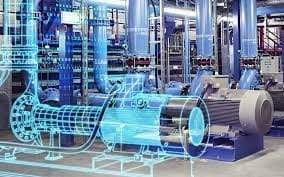Introduction: Digital Twin – Oil and Gas
Many people are asking about digital twin oil and gas applications for good reason. Digital Twin oil and gas usage is gaining broader adoption across the industry due to the ability to dramatically improve safety, inspection insights and reduce costs. There are several different definitions for digital twin oil and gas or “digital twins”, however, that can result in confusion. In general, we see two broad categories of digital twins, also known as visual digital twins or digital twin reality models:
Performance Simulation Digital Twin
Mathematical Model Simulation
- Predictive maintenance
- Asset performance and reliability projections
- Simulation and variable modeling
- Metrics-based
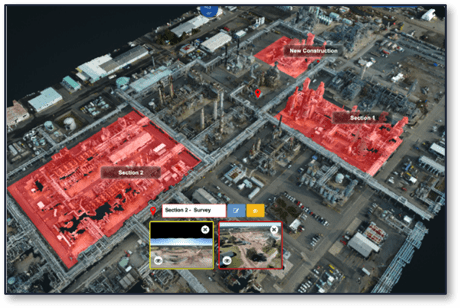
Visual Inspection Digital Twin
Physical Object Digitization
- Asset inspections
- Maintenance actions
- Measurements and analysis
- Visually-based
In this article, we are referring to visual inspection digital twins, or 3D digital twin models of the physical world.
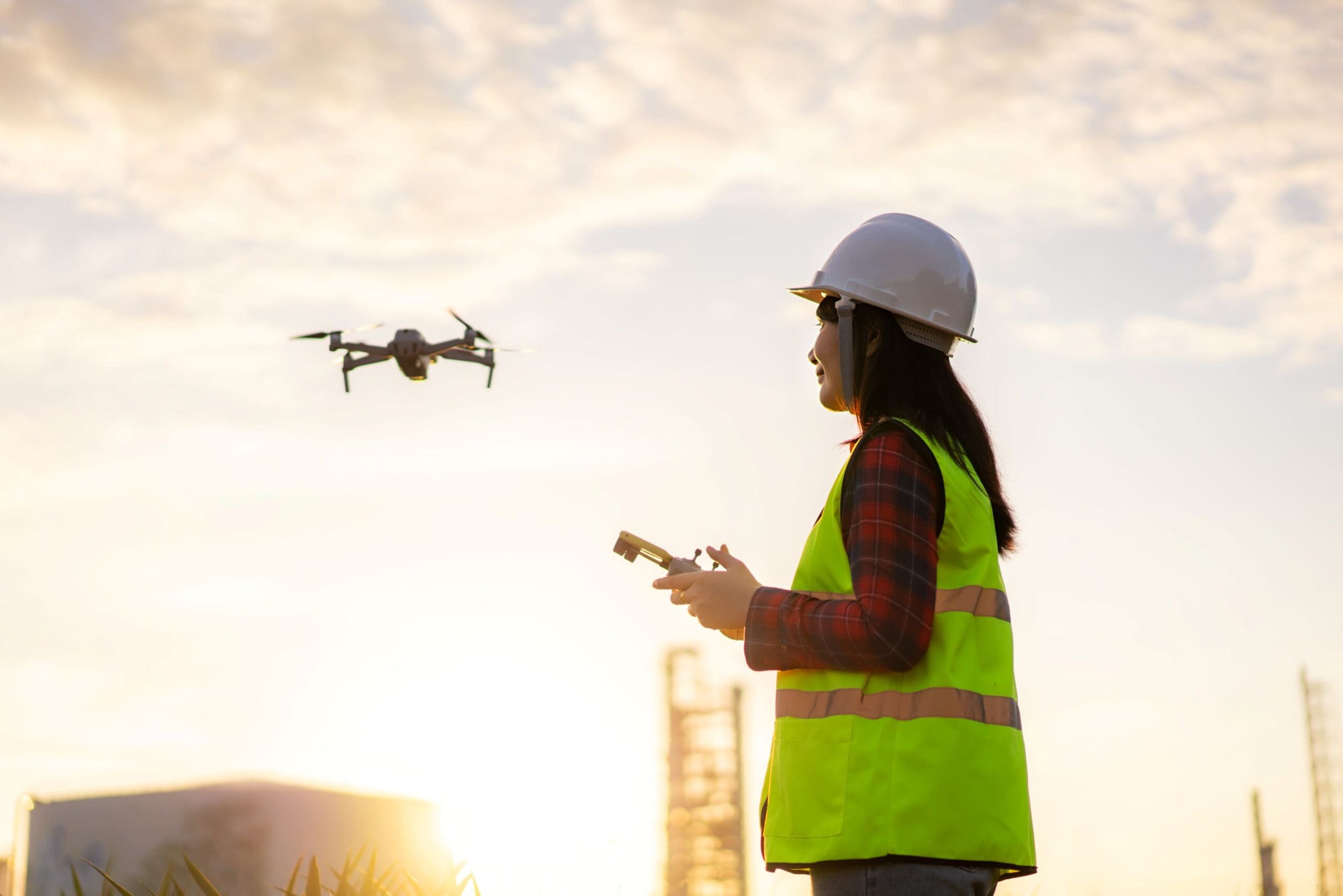
3D Digital Twin oil and gas models of sites or assets are created by capturing hundreds of images via drone. These images are captured at specific angles, distances and overlap by highly trained, FAA-certified pilots. These images are transformed into 3D virtual twin models utilizing photogrammetry to create precise pointcloud and mesh models.
Understanding Digital Twin Oil and Gas Uses
To comprehend the essence of digital twins or visual 3D Digital Twin models, it is essential to first grasp the digital twin oil and gas usage concept. A digital twin is a digital replica of a physical object, in extreme detail (accurate up to 1mm), that mirrors the physical object in every way. It uses real-world image data, collected through sensors and other sources, to replicate the visual characteristics and status of its physical counterpart. This allows engineers, designers, inspectors, managers and operators to monitor, analyze, and evaluate the physical entity without the need to visit the actual location.
Types of Digital Twin oil and gas models: Mesh and pointcloud models
There are two main types of digital twin models that are being constructed today: the 3D mesh model and the pointcloud model. While they are both digital 3D model representations of physical assets, they are constructed using different technologies, look slightly different, and ultimately have different applications. The Optelos platform can manage wither type of model, and when we’re collecting drone data for our customers, we typically use the captured data to build both model types to support their diverse goals.
-
3D mesh model
3D meshes use X, Y and Z axes to define shapes. The vertices are the coordinates in three-dimensional space, the edges each connect two adjacent vertices, and the faces (also called polygons) enclose the edges to form the surface of the object. These models are visually more photorealistic and offer high-definition visualizations of physical objects, but they should not be used for measurements or detailed angle analysis without a reference measurement. They are mostly used for conducting visual inspections or graphical presentations due to their realism.
-
Pointcloud model
A point cloud is a set of points in space that represent the surface of an object. Each point contains several measurements, including its coordinates along the X, Y, and Z-axes, and sometimes additional data such as a color value, which is stored in RGB format, and luminance value, which determines point brightness. The points are typically created by a 3D scanning method, such as LiDAR or photogrammetry, which measures the distance between the scanner and nearby objects. Photogrammetry is the process of creating measurements from pictures. It uses photos of an object taken at different locations to triangulate points on the object and plot these points in 3D space. Regardless of the method used to create the pointcloud, these models are highly accurate and can be used for measurements, but they are typically not as photorealistic as mesh models. For this reason, customers typically use pointclouds for taking distance and angle measurements.
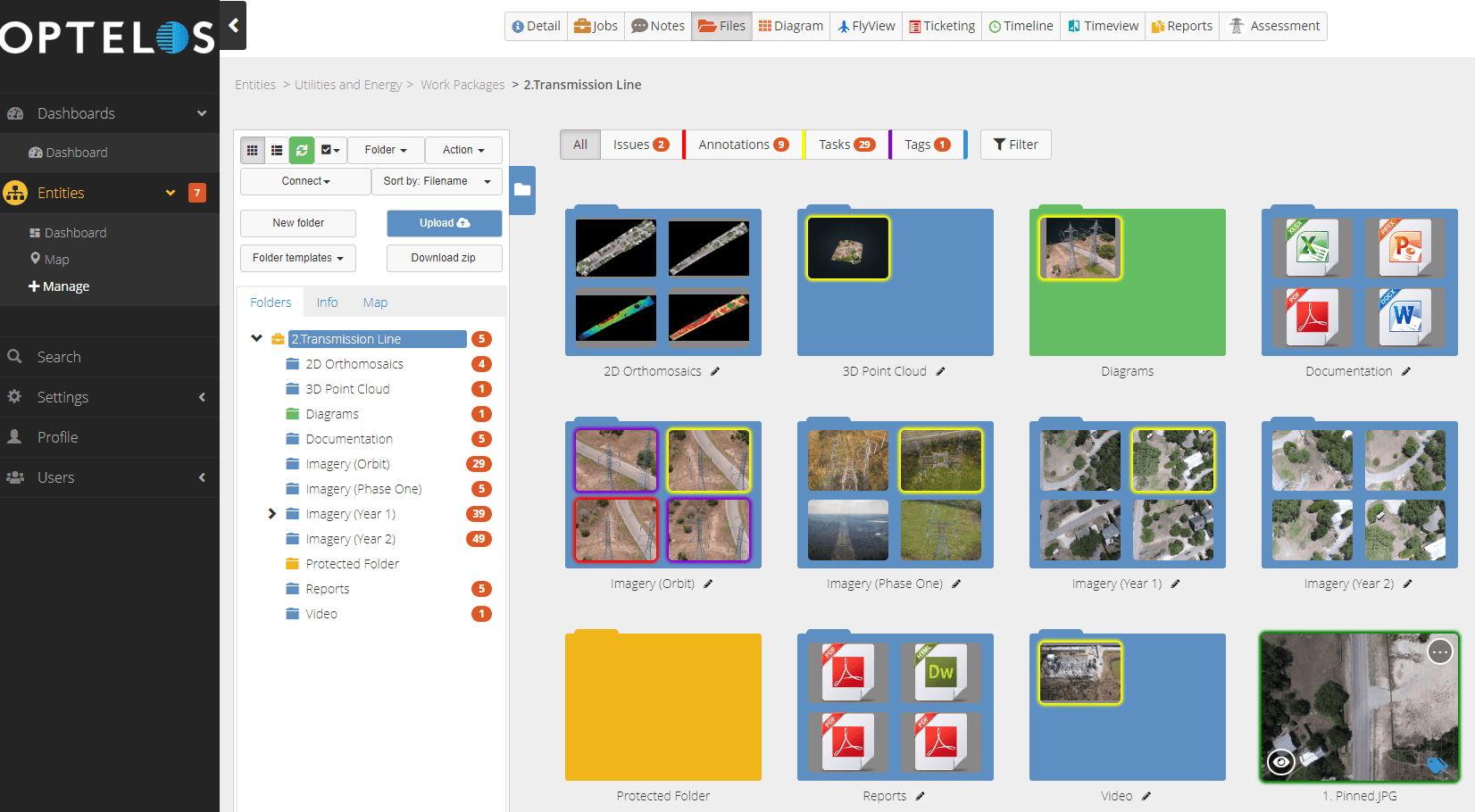
Images collected via drone data capture are uploaded into Optelos and submitted for photogrammetry processing. From these images, Optelos can create 2D orthomosaic maps, pointcloud models suitable for making precise measurements and detailed analysis, and photorealistic 3D mesh models perfect for visual inspection.
The Anatomy of a Digital Twin
Creating a detailed Digital Twin oil and gas model involves several crucial components:
Data Collection
The foundation of a Digital Twin oil and gas model is built on drone-based data collection. Highly trained, FAA-certified pilots will capture the drone imagery utilizing techniques learned from hundreds of hours of experience to gather the correct number of images at the correct angles, distance, resolution and overlap that are required to build an accurate virtual twin model.
Data Processing and Integration
The collected data is processed and integrated into a cohesive digital twin model. Advanced algorithms handle data fusion, ensuring accuracy and reliability. The images are processed utilizing photogrammetry to create precise point cloud and mesh 3D models. For Optelos customers, the images are uploaded and submitted via the Optelos visual data management platform.
3D Model Construction
The digital representation is transformed into a sophisticated 3D model that mirrors the physical entity. This involves mapping textures, materials, and geometries to create a realistic appearance.
QA and Image Analyst Corrections
The final step in building an accurate digital twin oil and gas model is to have an experienced image analyst review the 3D model for completeness and accuracy. Missing or imperfect model segments may require additional data capture to address the virtual twin defect, or removing images from the model construction data set to remove visual noise or correct for oversampling.
Applications of Visual Digital Twins
Most asset-intensive industries are moving aggressively to adopt drone-based inspection and virtual twins to improve their asset management, reliability and maintenance programs. While oil and gas is a key application industry, there are many other industries where digital twins are being successfully utilized:
Process Manufacturing
3D Digital Twin oil and gas models are revolutionizing manufacturing by enabling real-time monitoring of production lines, predicting machine failures, and simulating production scenarios to optimize efficiency.
Telecommunications
Leading telecommunications companies are utilizing drone-based inspections and data capture to build virtual twins of cell towers to validate lease integrity, antenna skew, identify and remediate PIM, and automate TIA’s and closeout packages.
Oil and Gas
Oil and gas companies are leveraging virtual twins for managing and overseeing capital projects and shutdown, turnaround and outage (STO) pre-project planning, project monitoring and sharing of critical asset inspection information.
Energy Utilities
Inspecting large, complex and often dangerous assets such as hydroelectric dams, wind turbines, solar farms, sub stations are made easier utilizing virtual twins.
Commercial Roofing
Highly accurate roof assessments and takeoff plans are enabled by creating 3D Digital Twin models using roof inspection by drone. Precisely identify roof pitch, defects and obstructions at elevation, leading to more accurate quotes and material planning without ever putting an employee in a dangerous inspection situation.
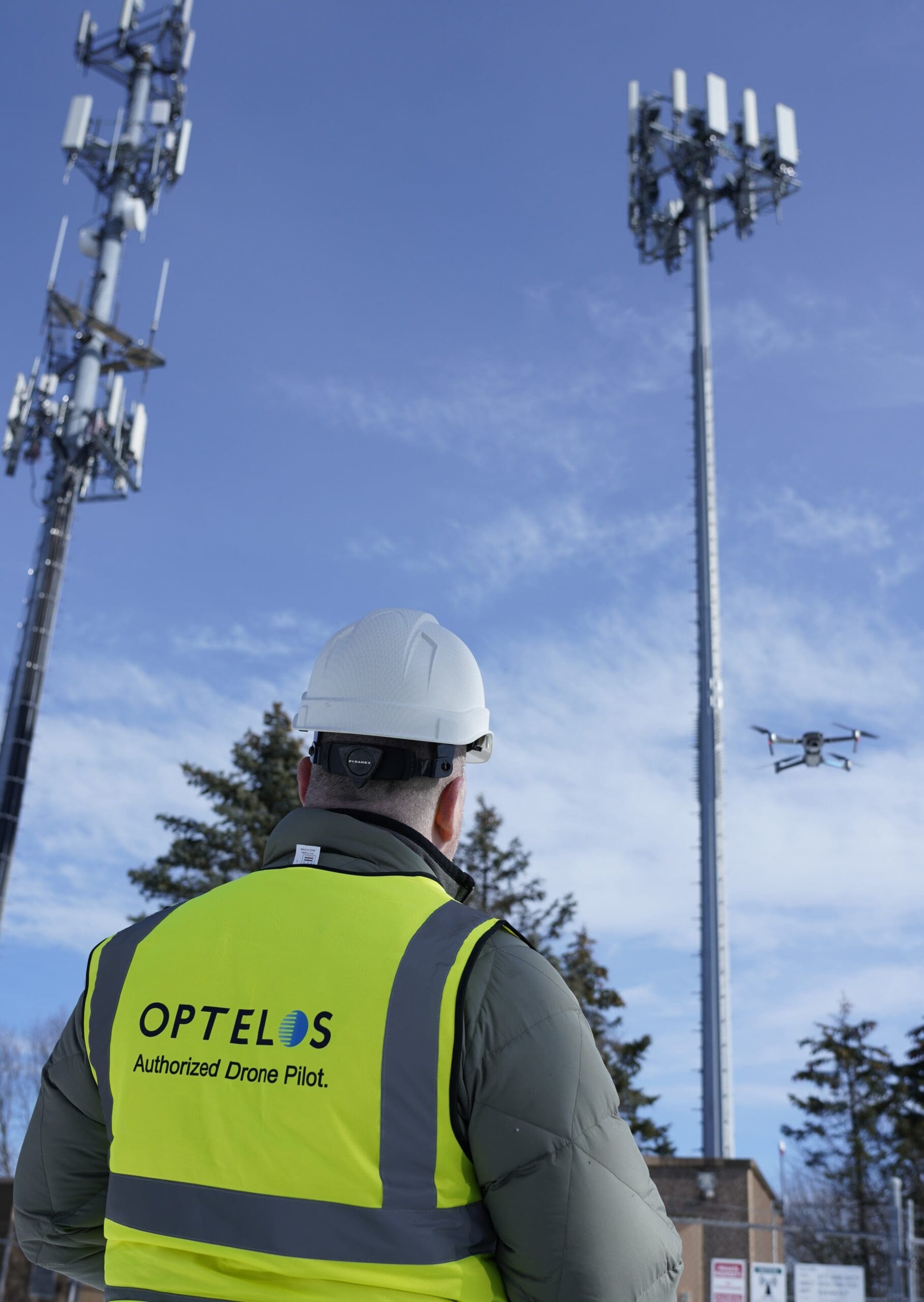
Streamlining and Automating Inspections
Organizations across many industries are facing a major human resource issue with impending retirements of their most experienced and knowledgeable employees. The electric utility industry, for example, estimates that by 2030, 40% of their current employees will be eligible for retirement. The digitalization of inspections will allow virtually any industry to do more with fewer employees, helping mitigate the impact of these valuable employee losses by digitally retaining this knowledge.
Benefits of Digital Twins
Improved Decision-making
The visual aspect of a Digital Twin oil and gas models make complex data more accessible and understandable, leading to better-informed decisions.
Enhanced Collaboration
Digital Twins facilitate communication between various stakeholders, as everyone can visualize and interact with the same digital model.
Cost and Time Savings
By identifying potential issues early on and optimizing processes, Digital Twin oil and gas models can save significant costs and reduce project timelines.
Predictive Maintenance
Digital Twins can be used to accurately predict maintenance requirements, reducing downtime and prolonging the life of physical assets.
Innovation and Creativity: The immersive experience offered by 3D Digital Twins fosters innovation and encourages creative problem-solving.
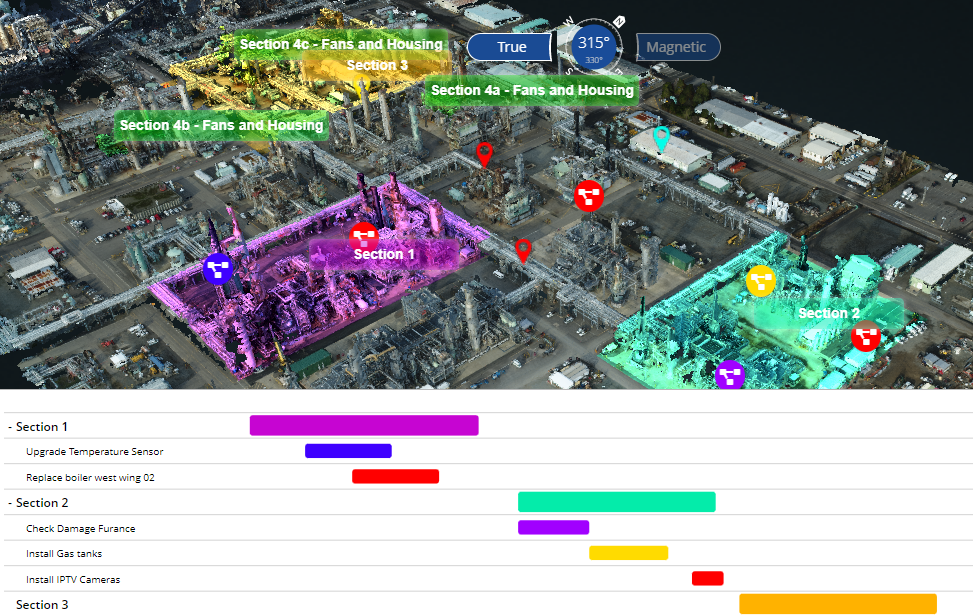
Digital Twins are utilized in TAR program management. Turnaround managers can group and track individual project areas separately, embed critical project plans, and annotate the virtual twin models with inspection notes, tasks or documents to improve the safety of maintenance actions.
Challenges and Future Prospects
While 3D Digital Twin oil and gas models hold enormous potential, their usage also faces challenges. Storage and access concerns are often issues faced by enterprises working with Digital Twins due to the large size of the files and the underlying software needed to open and manipulate the files. Additionally, developing sophisticated 3D models and keeping them updated can be resource-intensive. These problems are addressed by utilizing a platform like Optelos, however, which handles 300GB+ models and includes file viewers so that anyone with access to the Optelos platform can open and view the models without requiring any additional underlying software licenses.
Looking ahead, the future prospects of 3D Digital Twin oil and gas models is promising. Advancements in AI, machine learning, and rendering technologies will further enhance their capabilities. As the adoption of Digital Twins becomes more widespread, the virtual world will intertwine even more closely with the physical world, revolutionizing industries and transforming how we interact with our surroundings and enabling further remote inspection, process digitalization and inspection automation.
Conclusion
The Digital Twin oil and gas 3D model is a transformative technology that takes the already revolutionary idea of process digitalization to new heights. By integrating data-driven insights with sophisticated visualizations, Digital Twin oil and gas 3D models empower decision-makers and stakeholders to understand, explore, and optimize physical entities with ease from anywhere in the world. With applications spanning various industries and the probability of further significant advancements, the Digital Twin is undoubtedly a transformative force for asset inspection and asset management that will shape the future of industrial maintenance programs globally. By improving the safety and cost position of companies through inspection automation and defect detection, digital twin oil and gas pointcloud and mesh models will continue to gain adoption and provide a strong point of competitive advantage to the companies that embrace them.

